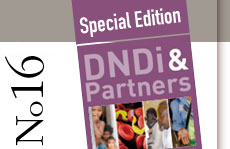 |
|
|
|
|


As a virtual R&D organisation, DNDi navigates through the complex and lengthy drug discovery and development processes by setting up effective partnerships with public and private organisations. These partnerships bring together diverse complementary capabilities necessary for developing new treatments. From individual investigators, independent experts, academic groups, NGOs like Médecins Sans Frontières (MSF), major research centres, public institutions, other Product Development Partnerships (PDPs), biotech companies, and fully integrated pharmaceutical companies, DNDi has built a sizeable network which consists of a diverse group of players.
This network is reflected in more than 250 agreements concluded within the past 5 years. The success lies in bringing together individual, public and private partners, regardless of their different motivations, who are committed to joining forces in our R&D process to make a significant difference for patients suffering from neglected diseases.
There are multiple key factors critical for effective partnerships in this field:

Foremost is that we share a common needs-driven objective for those suffering from neglected diseases. We were fortunate to forge close ties with key actors from different spheres. We are particularly pleased to note the recent trend of increasing levels of awareness and commitment to foster innovation for neglected diseases in both commercial organisations and academic institutions. Scientists working on the collaborations projects are passionate about their work, but notably the senior management is willing to put their organisational resources and expertise behind these collaborations.

The virtual model promises to deliver timely scientific innovation as soon as streamlined collaborative management processes are defined and put in place. An excellent illustration of this approach is the FACT Consortium which managed to develop, register, and deliver two new fixed-dose combination drugs for malaria that are simple, affordable, and well adapted. This result came about by means of a very clear partition of roles and responsibilities.

Although DNDi operates mostly in a virtual model for which our project managers orchestrate and coordinate activities within the partnership networks, it is nevertheless essential to conduct clinical trials in endemic regions that meet international standards. We form partnerships with groups and investigators in the endemic regions that go beyond the virtual model. We invest in infrastructure and are committed to strengthening capabilities in these regions to accomplish our objectives. The fight against human African trypanosomiasis (HAT), is therefore undertaken in collaboration with the national control programmes of the 5 most affected countries (Uganda, Democratic Republic of Congo, Republic of Congo, Sudan and Angola). Similarly, the fight against visceral leishmaniasis (VL) is within the Leishmaniasis East Africa Platform (LEAP), a regional clinical research network which aims at facilitating clinical testing and registration of new treatments for VL in the region, notably in Ethiopia, Kenya, Sudan and Uganda. Both platforms play key roles in strengthening existing capabilities where crucial clinical investigations are taking place, (see articles under Clinical Projects).

Partnerships with donors play a major role as well. We operate in diverse, resource-limited, and sometimes politically unstable environments. Our staff in the field need the flexibility to adapt to changes as they occur. This can only be done with the trust of donors: governments, international and supra-regional organisations, private foundations, and individuals. DNDi is very grateful for the support and confidence from our donors (see articles under Fundraising and Advocacy), who were instrumental in enabling DNDi to carry out its mission, specifically for its core organisational funding. This allows DNDi more independence and flexibility to make its own decisions that will ultimately satisfy the patients' needs. In return, DNDi has further strengthened its reporting and evaluation capacities in order to ensure optimum transparency regarding its decision-making and use of donor funds.
While we have made strides in our first 5 years, many challenges lie ahead. As we register new drugs, we have to decide on what role DNDi will play in ensuring that patients in need have access, that the products will be used effectively and appropriately, while also keeping an eye on resistance monitoring. When treatment options do exist, how do we ensure that the patients are offered the best treatment choice? The solutions may not be apparent, but as we blaze the trail, we will also learn to tackle these challenges with our public and private partners as well as other Product Development Partnerships, and will continue to share our experiences.
In the past 5 years, the landscape of R&D for neglected diseases has changed significantly. Greater attention and resources have been committed to global health and to the development of new drugs for poverty-related neglected diseases. DNDi has significantly contributed to this change of landscape, offering a more sustainable and harmonised R&D framework. In our quest for new treatments for the most neglected diseases, we will continue to forge new partnerships. Through continued collaborative efforts with innovative approaches, DNDi, along with our partners, remains driven by a steadfast determination to make a difference for people affected by neglected diseases, in the most timely and cost-effective way.